The gargoyle gecko (Rhacodactylus auriculatus) has plenty of devotees, but it is often overshadowed by two of its closest relatives: the incredibly massive New Caledonia giant gecko (Rhacodactylus leachianus) and the ubiquitous and popular crested gecko (Correlophus [formerly Rhacodactylus] ciliatus).
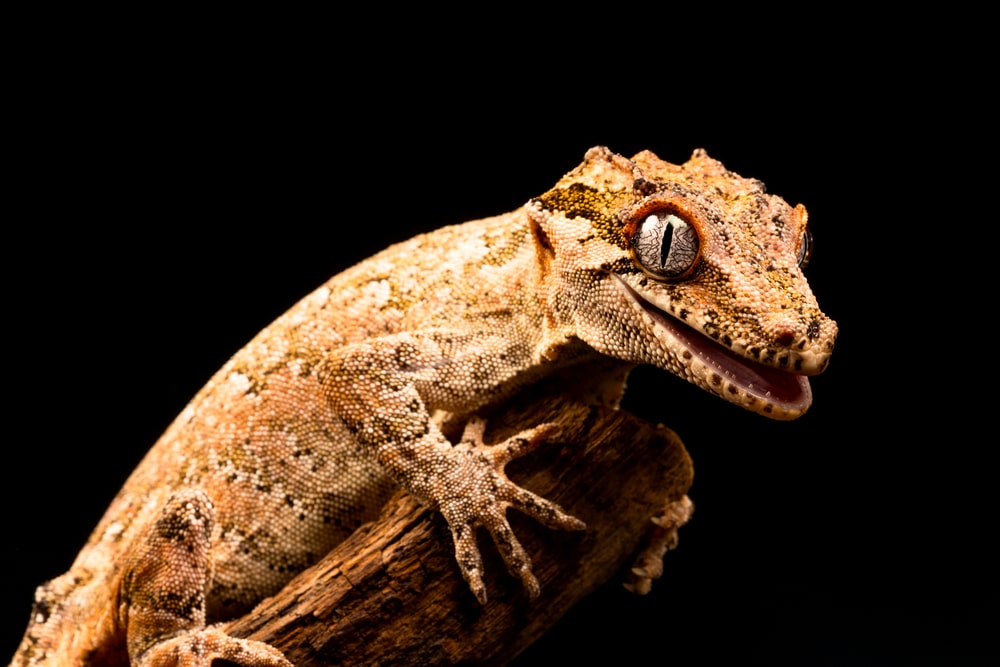
But that’s a shame because gargoyle geckos are very interesting lizards, which can make good pets in the right hands.
If you find yourself in the market for a new pet lizard, check out the care information below and consider inviting a gargoyle gecko (or two) into your home.
Quick Navigation
About Gargoyle Geckos
For the unfamiliar, gargoyle geckos are medium-sized geckos, who reach about 8 inches in length. They come clad in a seemingly endless number of color and pattern variations; they can range from gray to red in color and feature banded, striped or mottled/blotched patterns.
Their common name stems from the numerous bumps or protuberances on their heads, which can give the impression of horns or ears.
Range and Natural Habitat
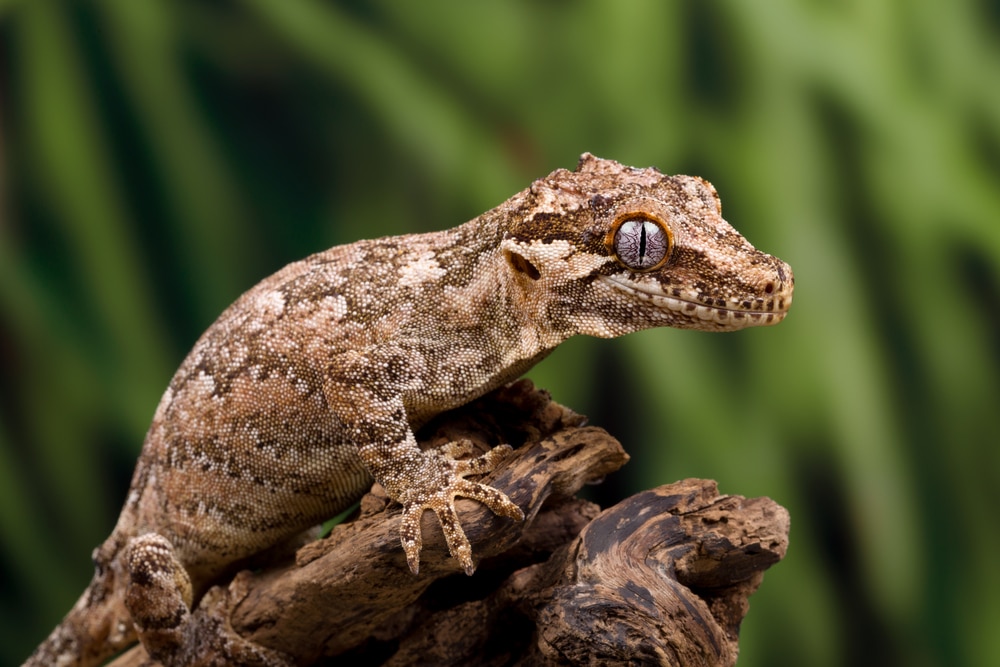
Gargoyle geckos are only native to the southern portion of New Caledonia – an island located in the southwest Pacific Ocean.
They primarily inhabit scrub forests and shrublands at less than 1,000 meters of elevation.
Gargoyle geckos can occasionally be found on the ground (such as during egg-deposition), but they’re primarily arboreal lizards, who spend most of their time in tall shrubs and trees.
These lizards are under considerable pressure in the wild thanks to habitat destruction, but fortunately, they’re regularly bred in captivity.
Setting up a Gargoyle Gecko Habitat
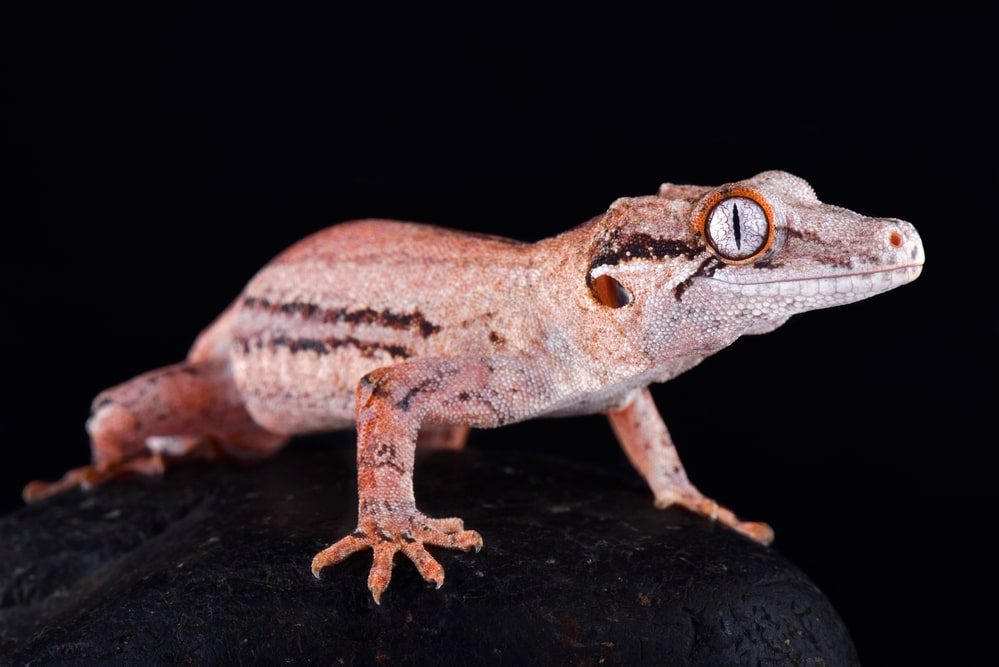
Here are a few things you should know about setting up a gargoyle gecko habitat:
Enclosure
There are a variety of different enclosure styles that’ll work for crested geckos, but plastic storage boxes and glass terraria are the two most popular (and effective) options.
Plastic tubs will require some modification to work (such as drilling ventilation holes) and they won’t allow you to see your lizards very well, but they’re more affordable, durable and easier to move than glass terraria are.
Nevertheless, either style will work.
Many keepers maintain their gargoyle geckos in habitats roughly equivalent to a 10- or 20-gallon aquarium.
However, larger habitats will give you more space to add plants or other decorations and provide more “elbow room” for your pets.
As long as you provide your pet with plenty of visual barriers and places to hide, there’s no reason you can’t provide more spacious accommodations.
Note that it is generally preferable to use front-opening enclosures when maintaining arboreal geckos.
This will often make it easier to prevent them from darting out of the habitat when you open it.
Heating and Lighting
Generally speaking, it is pretty easy to provide proper heating and lighting for gargoyle geckos – in fact, many keepers find that neither lights nor heating devices are necessary at all.
For starters, gargoyle geckos require lower temperatures than many other common pet lizards do.
Temperatures between about 70- and 80-degrees Fahrenheit are ideal, and many hobbyists find that it is possible to maintain temperatures within this range without the need for heat lamps or similar devices.
Nevertheless, it can still be advantageous to establish a thermal gradient (a range of temperatures) within the habitat. This will allow your pet to thermoregulate as necessary by moving throughout the enclosure.
Just be sure to monitor the habitat temperatures and avoid using high-powered heating devices to do so – a very low-wattage bulb will create a “basking spot,” and the temperatures will fall with increasing distance from the bulb.
Additionally, gargoyle geckos are largely nocturnal lizards, who will tend to remain hidden and inactive during the day.
Accordingly, the ambient light entering the habitat is typically sufficient for their needs.
Fluorescent lights can be installed over the habitat, but care must be taken to ensure they don’t cause the habitat temperature to rise too high.
Enclosure Substrate & Decor
You don’t want to just buy a glass terrarium and throw your lizard inside – you’ll need to add some type of suitable substrate and a bit of cage furniture to ensure he feels comfortable.
There are a variety of substrates that’ll work well for gargoyle geckos, including cypress mulch, orchid bark, coconut husk, paper towels and newspaper.
Mulch, bark and coconut husk all look great and will retain moisture, but they can also cause intestinal obstructions if your lizard accidentally ingests some of the material.
Accordingly, most experienced keepers encourage beginners to opt for paper towels or newspaper.
Your gecko will also need some branches and similar items to serve as climbing “highways” he’ll use to move around the enclosure.
You can use real branches if you like, but it is important to wash them off well before adding them to your lizard’s habitat. Alternatively, you can simply purchase fake branches from a pet-oriented retailer.
Your gecko will also need visual barriers and hiding spaces to feel secure. Artificial plants work well in this manner, but you can also use live plants.
Just be sure to use safe plant species, such as some of those discussed in our article about live plants for your vivarium. Paper towel tubes and egg crate sections can also be used to provide barriers and hiding places for your pet.
Gargoyle Gecko Care
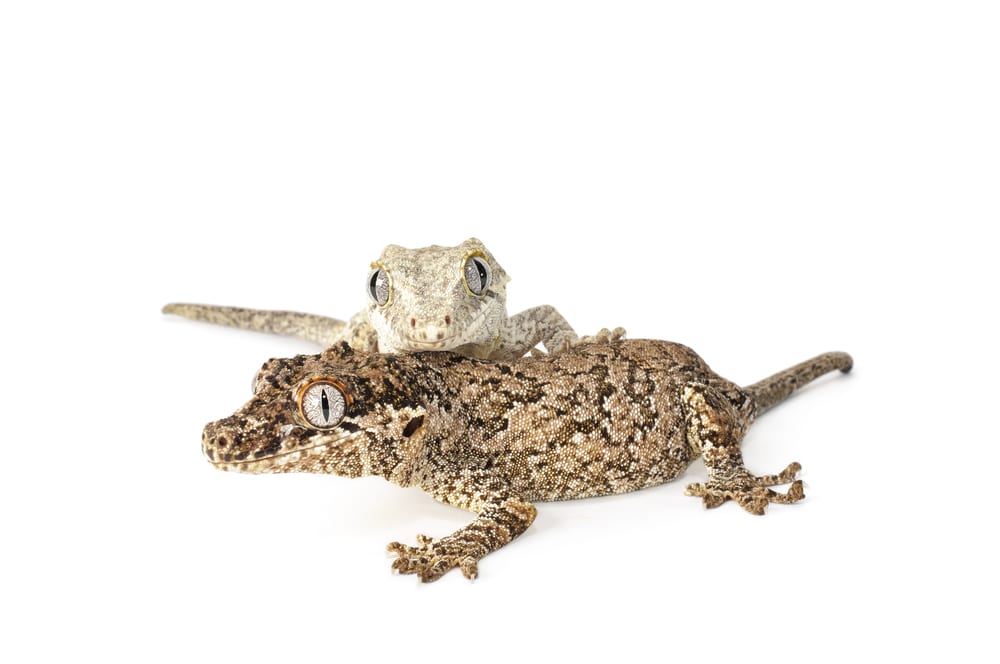
Here are a few things you should know about gargoyle gecko care:
Water and Humidity
Gargoyle geckos require fresh water like most other animals, so it is wise to keep a small dish of fresh, clean water available at all times.
However, some individual lizards will prefer to drink water droplets from the surfaces in their enclosure, so you may find it necessary to mist the habitat every day or every other day.
Just observe your lizard closely to ensure that he is getting water one way or the other.
The habitats from which gargoyle geckos hail often have moderately high humidity levels, and you’ll want to provide similarly damp air in your pet’s enclosure.
Most keepers aim for relative humidity levels of 50 to 70 percent, as this appears sufficient to keep them healthy and promote problem-free sheds.
You can raise the humidity level in the enclosure via misting or by adding water to your pet’s substrate. You can also reduce the amount of ventilation (slightly) or incorporate a large, shallow water dish in the habitat to increase the humidity as well.
Food
In the wild, gargoyle geckos consume a combination of foods, but insects and soft fruits likely represent the bulk of their caloric intake.
You can offer your gargoyle gecko some insect prey, but the bulk of his diet should come in the form of a commercial, fruit-based gecko food.
Some of these foods come ready-to-eat and feature a baby-food-like consistency, while others are powdered diets, to which you’ll need to mix in some water.
Many successful keepers offer a commercial food five to seven days a week, with the occasional handful of insects provided once a week or so. Still others feed a commercial gecko diet exclusively.
Indeed, some breeders have produced multiple generations of gargoyle geckos without feeding any insect prey at all.
Handling
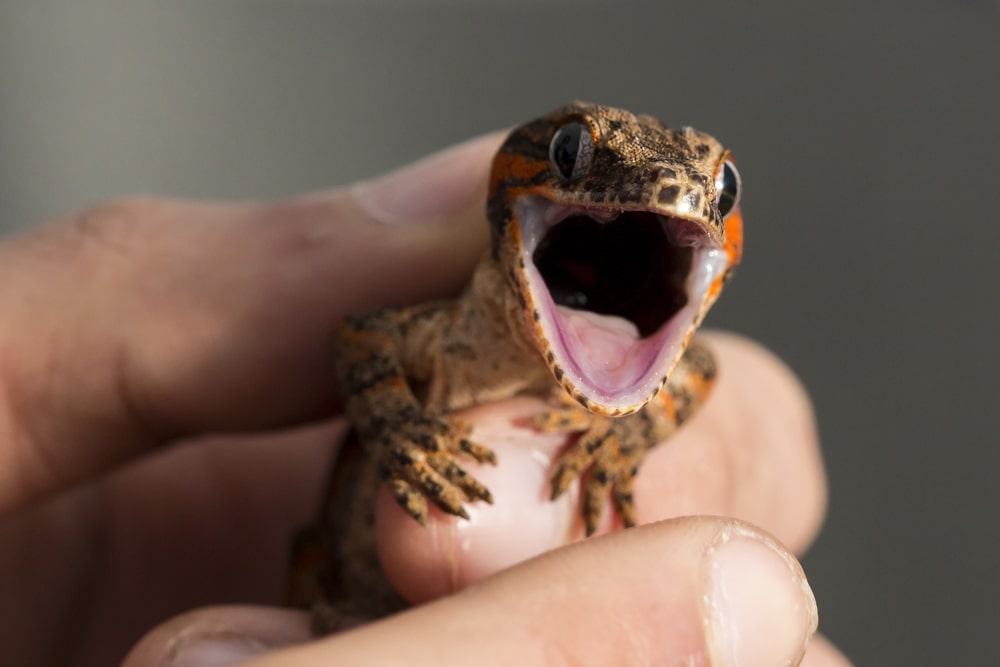
Gargoyle geckos are generally pretty docile lizards, but they shouldn’t be handled excessively, as they’re very quick lizards who are easy to drop and they’ll become stressed if handled too often.
Additionally, gargoyle geckos may drop their tails if they become frightened.
These tails will usually grow back, but the experience is likely stressful (to some degree) for the geckos, so it is wise to try to avoid such occurrences.
If you decide to handle your gargoyle gecko, try to do so in a calm room that is free of rowdy children or other pets.
Gently place your hand in front of the lizard and try to coax him into crawling on board – don’t pick him up by the body unless you absolutely must.
From there, allow him to move around on your hand as he wishes. It is wise – especially at the outset – to handle your lizard above a table or counter. This way, if he decides to jump, he won’t fall all the way to the floor.
Note that young gargoyle geckos are somewhat fragile and easily injured, so it is wise to wait until your lizard is several months old before you begin handling him regularly.
Common Health Concerns
Gargoyle geckos are generally hardy lizards who will remain healthy with proper care.
Nevertheless, they can suffer from a few common health concerns that you’ll want to watch out for. Three of the most noteworthy health problems you may encounter are discussed below.
Poor Sheds
Gargoyle geckos may occasionally retain portions of their shed skin. This normally occurs because the habitat humidity is too low, but it can also occur because of stress or (rarely) external parasites.
If the retained skin is on the lizard’s torso, the top of his head, or the upper portions of his limbs, you can usually just wet the area slightly and rub the skin gently to free it.
However, if the retained skin is located around your pet’s eyes, toes or vent, you’ll want to get your veterinarian’s help to free it, as these areas are delicate and easy to injure.
Try to prevent your lizard from experiencing future shedding difficulties by increasing the humidity level in the habitat and ensuring that your pet remains stress-free.
Respiratory Infections
Respiratory infections aren’t terribly common among gargoyle geckos, but they can be serious, so it is wise to familiarize yourself with the symptoms they cause.
Most geckos suffering from a respiratory infection will have a discharge from their nostrils or mouth – you may even see your pet “blowing bubbles.”
Sometimes, respiratory infections will also cause a lizard to rest with his mouth open or lay around listlessly.
In most cases, you’ll want to seek immediate veterinary attention to give your pet the best chance of a full recovery.
Just ensure that the habitat is within the appropriate temperature range and avoid stressing him in any way until you can get to the vet’s office.
Inappetence
Gargoyle geckos are usually easy to feed, but some individuals may occasionally refuse food.
This isn’t always a huge problem – lizards of all species occasionally don’t show an interest in feeding.
However, if it happens repeatedly, you’ll want to take steps to determine the cause of your pet’s diminished appetite.
A number of things can cause a lizard to refuse food, but stress, respiratory infections and internal parasites are three of the leading causes.
You can usually reduce your lizard’s stress level yourself, by simply ensuring that the habitat is set up properly, providing appropriate temperatures, making sure your pet has adequate hiding places and refraining from excessive handling.
Once your lizard starts to feel safer and more secure, he’ll likely begin feeding again voraciously.
On the other hand, respiratory infections and internal parasites will both require your vet’s help to address.
Fortunately, with appropriate medications, many lizards suffering from these ailments will recover fully.
Just be sure to seek veterinary help promptly to give your pet the best chance to return to good health.
Conclusion
Gargoyle geckos may fly under the radar a bit for many reptile enthusiasts, but they are very interesting lizards who can make great pets.
So, be sure to consider this species the next time you are seeking a new pet lizard.